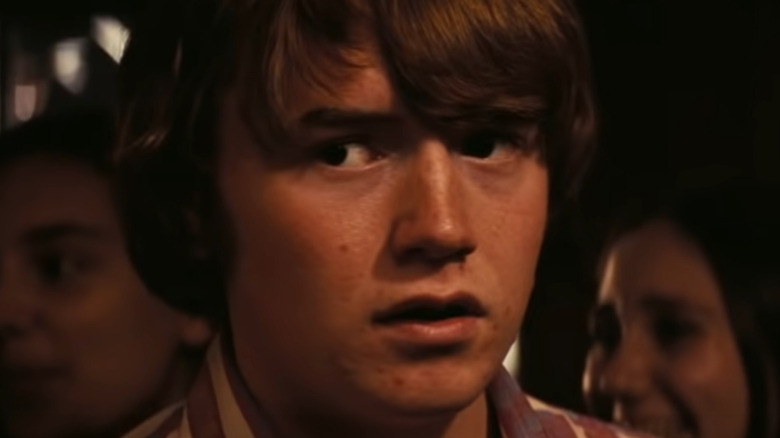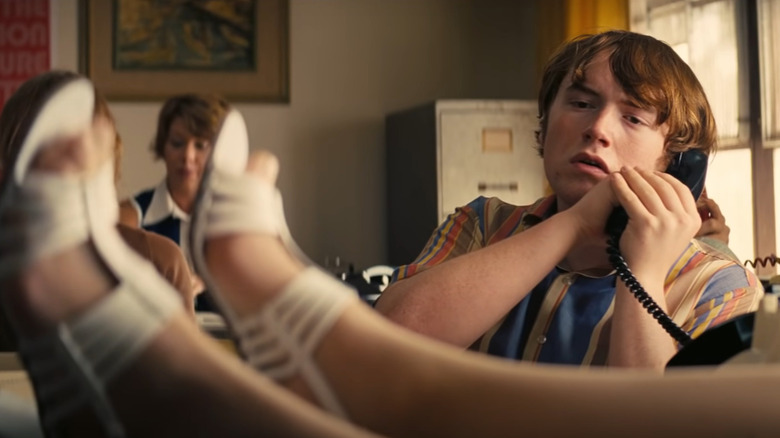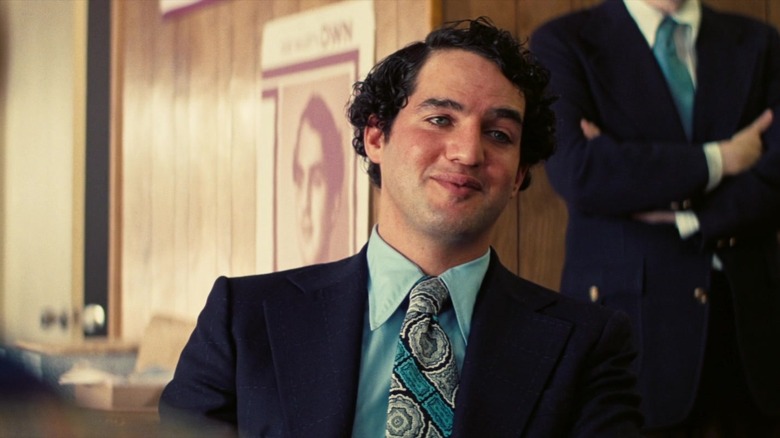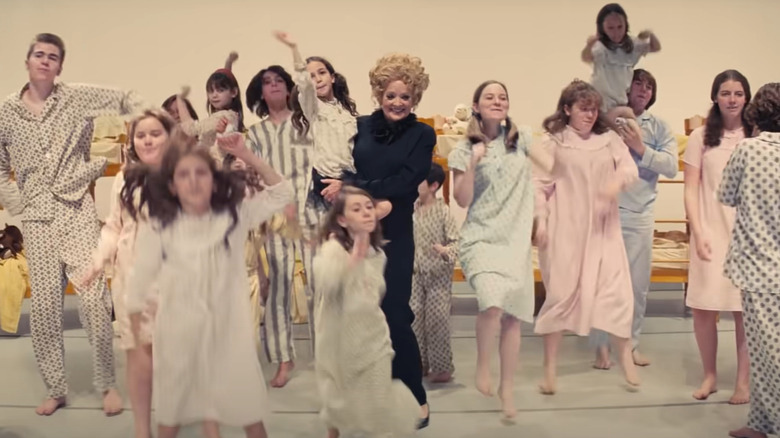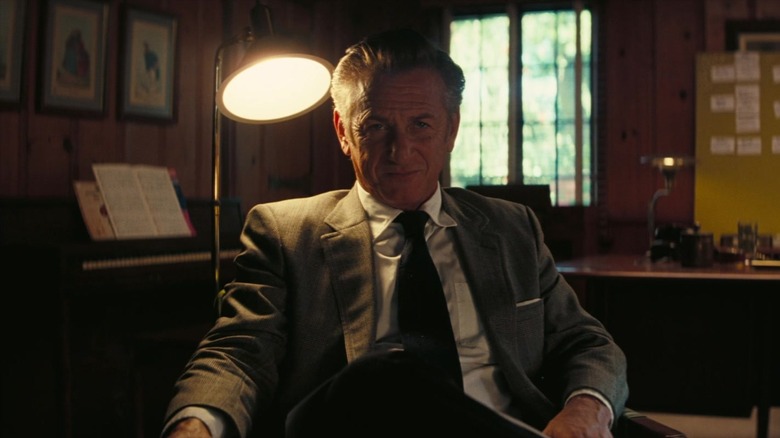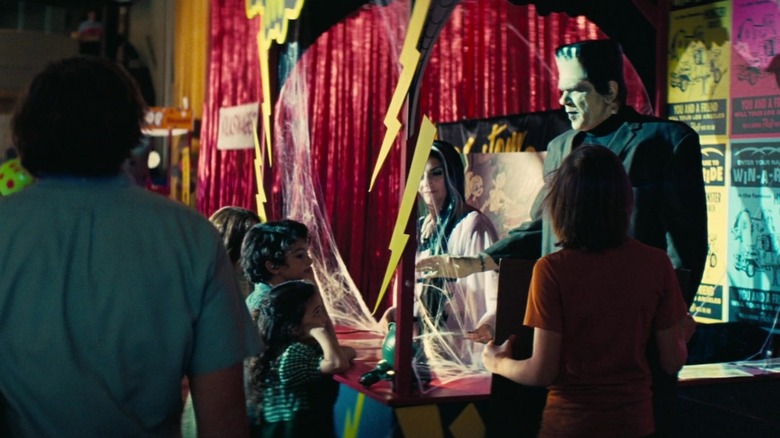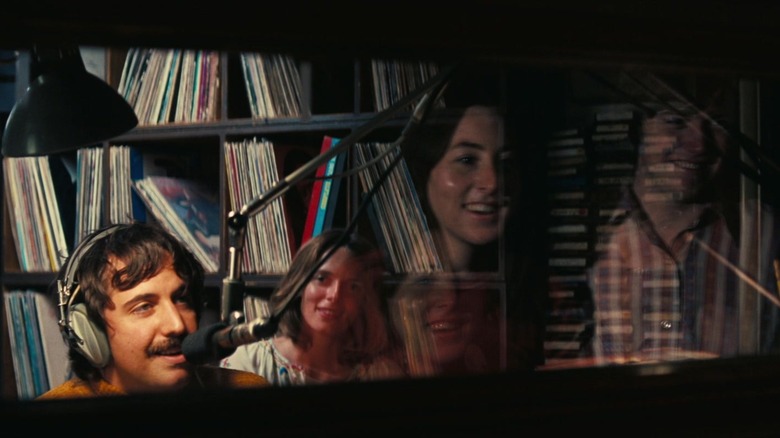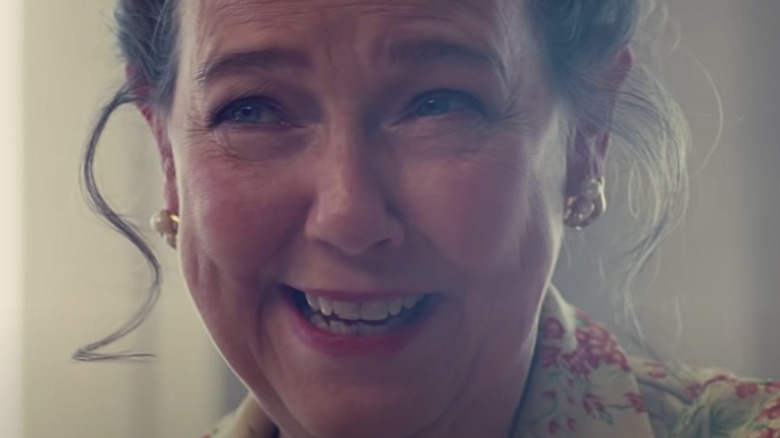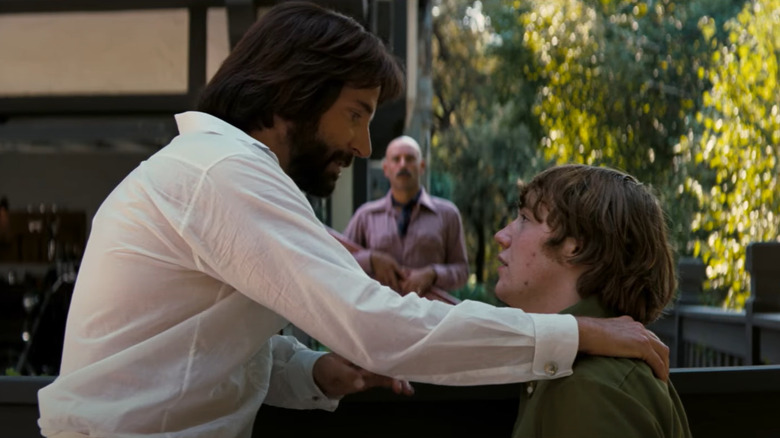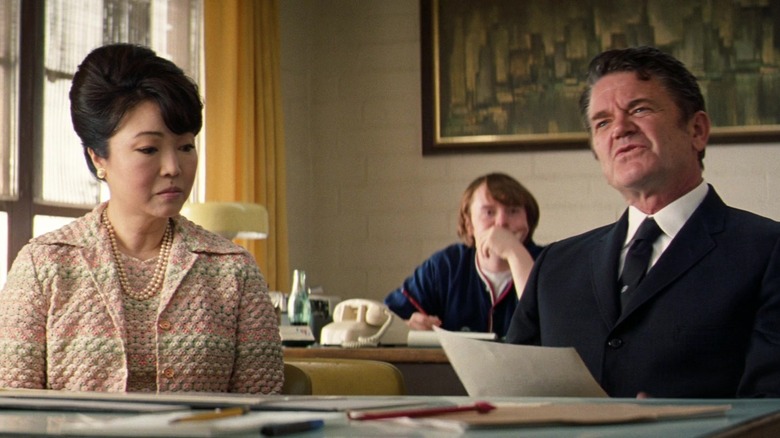Licorice Pizza Characters You Didn't Know Are Based On Real People
"Licorice Pizza" is a shaggy summer movie, a touching film about the confusing relationship between a 15-year-old and a 25-year-old, and a love letter to the neighborhood director Paul Thomas Anderson grew up in: the San Fernando Valley in the 1970s (per Variety).
While the 2021 film follows the courtship between Cooper Hoffman's Gary Valentine and Alana Haim's Alana Kane and their various money-making schemes over the course of a couple of months, it also painstakingly recreates the '70s Valley. Anderson's dedication to accurately portraying the period is staggering. The cars, songs, places, and clothes all make the movie play like a living, breathing time capsule.
However, inanimate details aren't the only references to the time period Anderson included in his film. He also filled the movie with characters plucked right out of Los Angeles, Hollywood, and even radio history. All of this accuracy creates a tapestry of interesting references, short cameos, and jokes about the types of people informing the lives of LA residents in the later 20th century. So to help fans clear up who's fact and who's fiction in Anderson's film, check out this list of "Licorice Pizza" characters based on real people.
Gary Valentine
Gary Valentine follows in the footsteps of a long line of Paul Thomas Anderson's specific brand of leading men. Gary's eccentric, charismatic, a touch egocentric, a born money maker, and in love. However, unlike other PTA creations like "Boogie Nights" hero Dirk Diggler, Gary Valentine was inspired by one of Anderson's real-life friends: Gary Goetzman.
In reality, Goetzman is a former child actor turned movie producer and co-founder of Tom Hanks' production company, Playtone. In his adult career, Goetzman helped back '90s and 2000s hits like "Philadelphia," "Silence of the Lambs," and "My Big Fat Greek Wedding." In an interview with Vanity Fair, Anderson told the publication his "source material was all these stranger-than-fiction stories Gary had told me over the years." Goetzman, like Anderson, also grew up in the Valley and was around the entertainment industry from a young age.
Plus, some of Gary's more unbelievable acts in the film are based in reality. For example, a feature in GQ confirmed Goetzman actually owned a waterbed business and a pinball palace in his teens. All this rich detail and stranger-than-fiction storytelling winds up on-screen. Inspiration for any artist can be hard to find, but with a friend like Goetzman around, it's no wonder Anderson felt he had to make this movie.
Joel Wachs
Hollywood types aren't the only folks represented in "Licorice Pizza" — Paul Thomas Anderson also puts real local politicians on-screen. For example, midway through the film, Alana Kane goes to work for real-life LA councilman and mayoral candidate Joel Wachs. While Alana initially has a crush on the candidate, she discovers Wachs has to hide his homosexuality from his constituents during a tragic scene between Wachs and his secret partner.
In reality, Wachs — played by actor and director Benny Safdie — unsuccessfully ran for mayor three times, first in 1973. He went on to serve on the LA City Council for 30 years from 1971 to 2001. In real life as in the film, Wachs was a closeted gay man for most of his civil service. He didn't openly come out until 1999 at the age of 60 (per the Los Angeles Times).
In an interview with radio station KCRW, the real-life Wachs reflected on his public career and his portrayal in Anderson's film, saying he hopes viewers see his story and register that "enormous changes have been made" since the 1970s.
In this way, Wachs' true story reflects themes Anderson often explores in his films including love, society's ethical perimeters, unfair exclusion, and perseverance. While there are tragic elements to Wachs' story, Anderson and Safdie bring a warm eye to the man who gave himself to his city even though his city didn't always accept Wachs' full self.
Lucy Doolittle
In reality, Gary Goetzman really did take a chaperone to New York City so he could appear on stage in a promo of the film "Yours, Mine, and Ours." However, in the movie, when Alana Kane chaperones Gary Valentine on his trip to New York, Gary appears on stage with the fictional actress Lucille Doolittle. Doolittle is a stand-in for the true-to-life 1950s sitcom phenom Lucille Ball (per Variety). (The real Gary, Paul Thomas Anderson explains, instead hired a "burlesque dancer who lived in his neighborhood" as a chaperone, per Variety.)
Anderson said regarding Lucille that he has a personal "moving target" when it comes to calling characters their actual names or creating on-screen stand-ins for their real-life counterparts (via Variety). Placing a stand-in like Doolittle for Ball was a wise choice because the film is not particularly kind in its portrayal of the aging starlet. While it's hard to know exactly what Ball was like in real life, it's more than likely that Doolittle's diva behavior (and open disdain for her child co-stars) was overdrawn to create comedic moments on-screen.
Anderson's decision to exaggerate Doolittle's nasty behavior also underscores the bizarre treatment of children in the entertainment industry. Moments like these tighten the movie's focus on the difference between adults, kids, and people like Gary and Alana, who remain adrift between the categories.
Jack Holden
In a hilarious scene — set in the legendary Tail O' the Cock restaurant and bar, faithfully recreated — Alana Kane goes on a date with famous actor Jack Holden (Sean Penn). The date goes south when Jack is talked into recreating a motorcycle stunt from one of his movies on a local golf course by a film director (Tom Waits). Holden makes the jump but blows the landing in a bit of physical motorcycle comedy.
Paul Thomas Anderson confirmed that the alcoholic Jack Holden was a stand-in for Golden Age screen legend William Holden (via Variety). For the uninitiated, William Holden starred in enormously influential movies like Billy Wilder's "Sunset Boulevard," Sam Peckinpah's uber-violent revisionist Western "The Wild Bunch," and even won an Oscar for his turn in "Stalag 17." Like his on-screen counterpart, the real-life William Holden struggled with alcoholism throughout his life.
Anderson explained his inspiration to put Holden in "Licorice Pizza," telling IndieWire William Holden "was the only actor [he] ever wanted to work with when [he] was younger." It's too bad Anderson never got the chance. William Holden's singular ability to convey earnestness turning into cynicism would've made him a perfect fit for PTA's unique vision.
If you or anyone you know is struggling with addiction issues, help is available. Visit the Substance Abuse and Mental Health Services Administration website or contact SAMHSA's National Helpline at 1-800-662-HELP (4357).
Herman Munster
Paul Thomas Anderson has accumulated quite the stable of performers over the years. From the irreplaceable Philip Baker Hall to all-time funny woman (and PTA's wife) Maya Rudolph and the late great Philip Seymour Hoffman — Anderson's got a serious Rolodex of talent. In "Licorice Pizza," another one of his frequent collaborators — John C. Reilly — shows up in a blink-and-you'll-miss-it cameo as Herman Munster.
Herman Munster was the lead character in the popular mid-'60s sitcom "The Munsters." The show, in a nutshell, is a mashup of other familial comedies like "The Brady Bunch" and classic monster movies from 1940s and '50s. Herman's a Frankensteinian monster, his wife and father-in-law are vampires, and his son is a werewolf. In the show, the undead patriarch Herman was famously portrayed by actor Fred Gwynne.
Mr. Munster pops up in a booth when Gary goes to the Teen-Age Fair, or Pop-Expo. While Reilly only shows up in the background of a beautifully composed tracking shot, his distinct voice makes him hard to miss. In a cheeky credits joke from PTA, Herman Munster is credited "as himself." While Reilly himself has specified he was playing "Herman Munster” (on "The Late Show with Stephen Colbert") and doesn't explicitly say he was playing Fred Gwynne, it's still a fun nod to popular culture from the '60s and '70s.
B. Mitchel Reed
Luckily for fans, Paul Thomas Anderson didn't limit the cameos to physical appearances. Much like Quentin Tarantino intercut 1960s LA radio broadcasts into his film "Once Upon a Time in Hollywood" (via IndieWire), PTA recreates legendary rock DJ B. Mitchel Reed's '70s broadcast with the help of voice actor Ray Chase.
In the 1960s and '70s, Reed was all over the airwaves on the enormously popular — and now-defunct — LA radio rock stations KFWB and KMET. However, Reed was more than just a voice on the air. A feature on the station's history and popularity in the LA Times credits the "incomparable" Reed with building KMET into the juggernaut it once was. Anybody interested in listening to Reed can check out a full hour from 1970 here.
In the film, Chase impersonates the DJ in a scene where Reed reads an ad for Fat Bernie's waterbeds over the radio. While Anderson could've had any radio DJ read the ad or made up a station, he decided to lean into the details of the time and place. It all adds to the specificity and charm of his story. Plus, he didn't just stop at replicating a KMET broadcast — the studio reconstructed a KMET billboard in the San Fernando Valley for shooting (per Los Angeles Magazine).
Mary Grady
"Licorice Pizza," like a lot of Paul Thomas Anderson's work, is a very, very funny film. One of the film's funniest moments occurs when Gary Valentine takes Alana Kane to meet his child actor-specific agent, Mary Grady (Harriet Sansom Harris). The back and forth between Alana and Mary is outstanding comedic work and an absolutely fiery performance from Harris as the agent.
However, Mary Grady isn't an original Anderson character. Anderson found inspiration for the character from a child agent of the same name (via Texas Monthly). While Mary wouldn't live to get to see herself played on the big screen — she died at age 96 in 2021 — she had a seriously magnificent career in Hollywood, representing a "Who's Who of TV child stars from the latter half of the 20th century" (per Deadline).
Her clients included Melissa Sue Anderson, who played Mary Ingalls on "Little House on the Prairie"; Erin Moran, who played Joanie Cunningham on "Happy Days"; and the Olsen twins, who played Michelle Tanner on "Full House." While it's doubtful that Anderson modeled his Mary Grady's behavior on that of the real woman, it's a nice shoutout to a legend in an often-overlooked entertainment industry role.
Jon Peters
One of the film's most tense episodes is Gary Valentine and Alana Kane's waterbed delivery to Jon Peters' (Bradley Cooper) house. Peters, a famous celebrity hairstylist-turned-producer who's dating Barbra Streisand, berates and threatens Gary when they arrive. Gary decides to get back at Peters, hijinks ensue, and a long series of cat-and-mouse games through the Hollywood Hills is kicked off. It's hilarious and slightly terrifying thanks to Cooper's performance as Peters. While the character may seem a bit ridiculous, he is in fact real.
The real Peters is something of a wild man and a bit of a villain. He did date Streisand and work his way up from hairstylist to movie producer (and the film "Shampoo" is partially about his life). He produced plenty in his career, but his biggest contribution is probably 1989's "Batman," since it proved that Hollywood comic book adaptations could bring in enormous sums of cash. However, he was also made to pay an assistant millions in damages for sexual harassment (per Today) and was entangled in various other scandals and affairs over the course of his career (via Business Insider).
In an interview with Variety, Paul Thomas Anderson explained that Gary Goetzman, the inspiration for Gary Valentine, really did deliver a waterbed to Jon Peters' house. However, PTA also said that he made up the ensuing drama for the movie. Given Peter's troubling history, it's no wonder Anderson decided to turn him into the movie's boogeyman for a few scenes.
Jerry Frick
While "Licorice Pizza" was nearly universally praised by critics, one pair of scenes created controversy for their portrayal of the relationship between a restaurateur and his various wives. In the film, the restaurateur, Jerry Frick (John Michael Higgins), speaks to both his first and second Japanese wives in broken English with an exaggerated accent.
In response to the scenes, the Media Action Network for Asian Americans, or MANAA, published a statement in The Rafu Shimpo decrying the film for mining laughs from casual displays of anti-Asian racism. MANAA called for film critic associations to stop heaping awards on the film. The Academy didn't drop the film's nominations, however "Licorice Pizza" didn't win any Oscars.
One interesting bit of information to emerge from the controversy is that Jerry Frick is based on a real-life LA restaurateur. The real Frick founded and owned Mikado, "the first Japanese restaurant in the San Fernando Valley," and also married two Japanese women (via The Hollywood Reporter). It may be impossible to know how the real-life Jerry Frick behaved, but Anderson did offer an explanation for the way the fictionalized Frick acts. When asked about the scenes in question in an interview with The New York Times, Anderson said he included the scenes to be true to the attitudes of the time.
